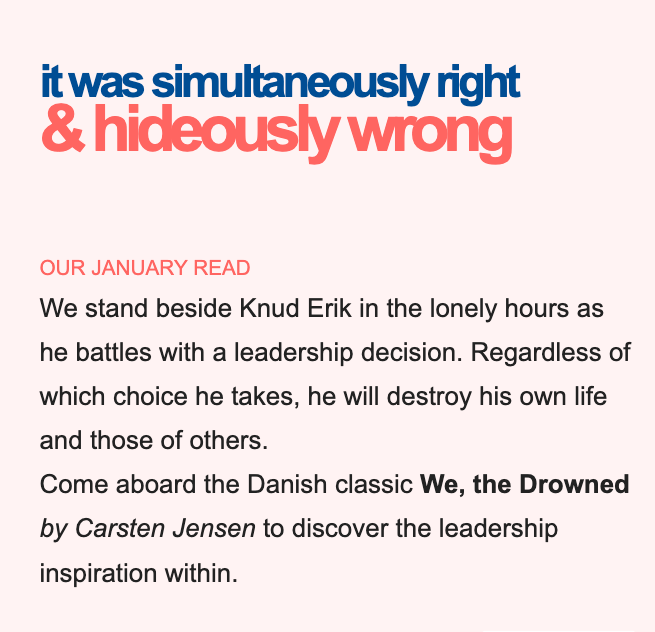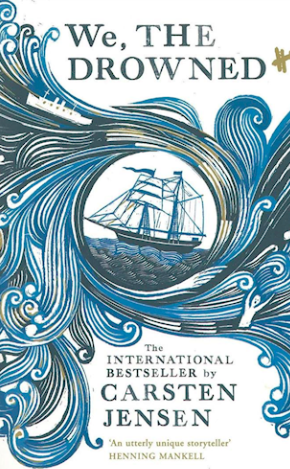Decisions that mark the soul


Leadershitship
A leader once was heard to say he that he did not care what happened to anyone in the organisation – unless that person’s results directly contributed to his bonus. The other leaders sat in silence. Later, another leader finally spoke up in admiration of the other leader’s honesty.
The phenomenon of leadership is one that occurs in the relationships between people. The balance between results and people is critical. When decisions are based on the bank account of a power holder, that is where leadershit happens.
Leadership is rare
To put the quote into the perspective of leadership, at this point in the story, we find Knud Erik sailing seas of drowning men and ignoring them.
There is a greater good, explains the leaders onshore. If a ship slows to rescue survivors of other sunk ships, it risks all lives and the lives of those depending on delivery of the cargo of essential war supplies.
As captain, Knud Erik follows orders which are “simultaneously right and hideously wrong”. As a leader executing the orders, he sails through waters filled with blinking red distress lights on life vests and voices crying out for help. Knud Erik finds himself merely watching from the bridge of his ship as limbs are caught in their propellers and men implode from depth charges. The blinking red distress lights fade into the distance, each one signalling a man left to die of exposure.
Decision to action
Decision making skills are considered a key aspect of successful leadership. The ability to use a broad frame for decision-making while simultaneously simplifying the process results in fast and accurate decision-making and is considered a strong leadership skill. A leader is expected to respond to knowledge rather than emotions. Deciding whether or not to follow the order results in Knud Erik feeling trapped by circumstance, and in order to both follow the required action, he takes a secondary decision.
Leaders arise in times of difficulty
A leadership conflict posed for us by reading We, the Drowned, is that we are bound to the changes in our world. Our lives and beliefs are defined on where we live and how we see life. Additionally, we are not in control of the situations we can find ourselves in. The world changes, events occur outside our control, and people react in unexpected ways.
Does Good leadership mean good decision making?
Knud Erik follows the premise of “good” leadership decision-making when he obeys the orders. He uses his knowledge and experience towards the greater good, at the cost of the drowning men around him. The human cost of the decision is what drives him to move from being a holder of a leader role to leadership.
Good decision-making requires knowledge of the human factors and human consequences.
Knud Erik takes the helm alone. He does this to shield his crew from being forced into the same experiences. The decision and action of taking the helm alone makes him the sole responsible for the execution of this order, and shields his crew from the mental pressure of taking lives and acting against the survival instinct and identity of sailors to save a drowning man.
or is it Responsibility at the cost of self?
Is that what makes the difference between a leader and a power holder? In We, The Drowned, Knud Erik mitigates the impact on the crew so they could function to keep the ship and convoy safe, sacrificing the price of his mental and physical health for emergency supplies. He watched men die so that others – some of them unseen along the logistics line – would survive. It was only external events that stopped Knud Erik’s decline from ending in a failed decision or a complete death of his soul.
If Knud Erik had passed on orders, it would have been his crew that were experiencing the horrors and increased the risk of a crew member breaking. However, Knud Erik’s decision to take it entirely on his shoulders risks his future abilities as a leader. What could have happened if he stood at the helm with his crew?
Life and death, or merely what to have for lunch?
Does the ongoing robustness of a leader depend on keep emotions out of the decision – regardless of the human cost? And how to do that without inviting dark traits or destructive leadership into power? Although we may hope we can opt out of a situation, real life and history show us that we often end up in relationships or environments where do not hold the expected levels of control.
At what price?
We, the Drowned offers an example of how the ever-changing nature of the world around us can put us into positions that challenge the core of who we are. Feeling trapped by circumstances has an impact on our perception of stress, and becomes a default factor in our decision-making and risk factor for subsequent mistakes. After all, we are only human and have our identities, values and conscience to live with long after the decision has been made.
Perhaps you are not at war or feeling alone at the helm as Knud Erik experiences, but we can all experience being at war with ourselves. Decision-making may very well depend on emotionless assessment – but the cost of that decision may not be acceptable to you or others.
What is the book about?
We, the Drowned is a complex weaving of lives encompassing nearly 200 years in a Danish sailing community. As we follow different characters, there are several themes that emerge. Community and conflict, the impact of change, transition from childhood to adulthood, and gaps between generations to name a few.
The grasping of power
A theme about the people who step forward to grasp power was also part of this novel. We, the Drowned demonstrates several characters who are motivated by personal desire, dark personality traits or personal bias.
Read past the individual stories
We, the Drowned covers a broad range of human behaviours and interpersonal interactions to reflect over. The storylines demonstrate over and over the passive inability to protect oneself or others when a destructive or malicious individual steps into power. When authority and power is wielded with cruelty and personal desire driving decision-making and actions there is an impact on each generation. The boys of the town always react to authority figures and respond to aggressive levels of control; however a learned helplessness develops that follows the boys as they move into adulthood and onboard ships.
In change, we seek what remains stable
Regardless of who holds power, the world is always changing. The young are being directed along a pathway changing with political instability and technological advancement, and each older generation finds themselves watching their way of life slipping away. There is an ongoing search for what is stable and underlying all of the separate experiences is a shared identity.
Community and identity both divide and unite us
Birth in Marstal comes with a predefined destiny and shared childish enemies. The micro-communities that exist onboard ship provides a fertile ground for cruelty and wielding of power, rather than leadership. Out of the eyes of the broader community, power imbalances emerge and the boys and men find values and identity challenged, often with deadly and meaningless consequences.
Values may be merely shadows of words that shake their beliefs, however identity can be held deep within a person and guarded fiercely and secretly. In We, the Drowned, the characters take their identity as part of the Marstal community – generations of seafarers and adventurers – into the wider world. Here it becomes a tool to help them find one another amongst strangers and becomes an undefinable secret part of themselves.
Women as wallpaper
Male dominant narratives push the female perspective into the background of the story. Women are described as being left alone to raise families, and subsequently the female narrative becomes a mere shadow in the main thread. There is an implied helplessness to the independence of the men, and the women remain acting out generation after generation to a duty to children and the future independent men.
The woman with unexpected decisions
Only one woman who seeks security reaps the rewards of unexpected power. With the removal of responsibilities, she follows a similar narrative path as the men – into an attempt to control her future. Following a narrow frame of perspective tainted by her bias and fear, the resulting decision-making develop into a case of disruptive leadership, unchecked by the passive larger group of the community who underestimate her intentions and abilities.
what happens after this quote?
In order to ignore survivors, Knud Erik makes another leadership decision and the crew respond with a decision of their own.
Knud Erik isolates himself, taking the full responsibility on himself and unable to connect, communicate or function with other people – both when at the helm and when at rest. Withdrawing into a lack of consciousness through alcohol, he feels he is operating out of himself. A state that is not sustainable and in leadership terms, risks future decision-making. In return, his crew uphold his isolation and keep their distance. Callous, I thought.
However, the crew’s decision to respect his isolation is described as shielding Knud Erik as their captain. In acknowledgement of the personal cost of his decision, they decide that any sign of sympathy would cause him to break down and fail as a leader.
“They shielded him so he could get on with the job of shielding them. They needed a captain and they gave him the chance to be that man.”
Knud Erik’s choice to take the consequences of the decision positively impacts the perception of his leadership amongst the crew, while simultaneously breaking down his mental and physical health.
In terms of the quote that we have worked with –
“It was simultaneously right and hideously wrong.”
You may have assumed that this line was from his decision-making to obey the rule to ignore survivors. However, this line is written at a point when Knud Erik eventually reaches breaking point and disobeys the rule.
As the situation around him dissolves into chaos, he flings himself into a life-threatening position in an attempt to salvage his own sense of humanity, and to save at least one survivor.
How to read this book
It is an incredibly detailed story. Characters are developed and discarded along the way, and the progression through time beautifully encompasses the fleeting impact of people on one another’s lives. To hold so many personalities and events within the pages makes it a difficult read. The trick to reading this book is the hooks and baits he lays out in the overlapping narratives to generate curiosity.
And like all books that make an impression on me, there were times that I just stopped to enjoy the words and the phrasing. The opening line, for example, captures my imagination:
“Many years ago there lived a man called Laurids Madsen, who went up to heaven and came down again thanks to his boots.”
It is a book to pick up and read a few pages every day – reflecting on each moment as a separate glimpse into a kaleidoscope of perspectives that comes together differently for us all.
